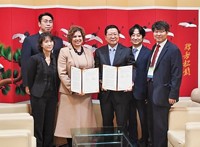Advertisement
Grab your lab coat. Let's get started
Welcome!
Welcome!
Create an account below to get 6 C&EN articles per month, receive newsletters and more - all free.
It seems this is your first time logging in online. Please enter the following information to continue.
As an ACS member you automatically get access to this site. All we need is few more details to create your reading experience.
Not you? Sign in with a different account.
Not you? Sign in with a different account.
ERROR 1
ERROR 1
ERROR 2
ERROR 2
ERROR 2
ERROR 2
ERROR 2
Password and Confirm password must match.
If you have an ACS member number, please enter it here so we can link this account to your membership. (optional)
ERROR 2
ACS values your privacy. By submitting your information, you are gaining access to C&EN and subscribing to our weekly newsletter. We use the information you provide to make your reading experience better, and we will never sell your data to third party members.
Policy
Globalizing Japan’s Chemical Society
International: Chemical Society of Japan wants to broaden engagement
by A. Maureen Rouhi
March 30, 2015

At the Chemical Society of Japan’s (CSJ) meeting on March 26–29, 8,500 attendees gathered at Nihon University’s Funabashi campus, outside of Tokyo. Chemistry was center stage of course, but among CSJ leaders, the buzzword was globalization. The society aims to engage more than ever with non-Japanese chemists as authors, meeting attendees, and members.
The society’s global strategy has three pillars—globalizing the annual meeting, increasing the competitiveness of CSJ journals operations, and broadening membership beyond Japan—CSJ President Sadayuki Sakakibara said.
To preface his call to globalize CSJ, Sakakibara drew upon his industrial experience. He is chairman of the board of Toray Industries and chairman of the Japan Business Federation, a key national position that is nicknamed “the prime minister of industry.”
At Toray, Sakakibara said, R&D is the way to the top. Toray’s global dominance in carbon fiber, for example, is due to “world-leading inventions and technologies,” he said, noting that only Toray’s carbon fiber is authorized as the material for the primary structures of Boeing airplanes.
However, Japan’s scientific output is falling short, Sakikabara observed. The number of chemistry papers from Japan trails those of China and the U.S., he said. The output is also dominated by work involving only researchers in Japan, whereas papers from other countries generally involve two or more international partners. Globalization and innovation go hand in hand, he suggested.
The strategy is bearing fruit. Of about 6,000 presentations, 25% were in English, up from 9% in 2014. “For this meeting,” CSJ Executive Director Nobuyuki Kawashima said, “Japanese attendees were highly encouraged to give talks in English to accelerate the society’s internationalization.”
CSJ is also taking steps to enable its journals—Chemistry Letters and Bulletin of the Chemical Society of Japan—to attract authors worldwide. For example, the journals are increasing international representation on their editorial boards and providing authors with citation reports.
International membership and meeting attendance still are limited, Kawashima said. CSJ hopes to make progress by intensifying engagements and promoting collaborations with international partners.




Join the conversation
Contact the reporter
Submit a Letter to the Editor for publication
Engage with us on Twitter